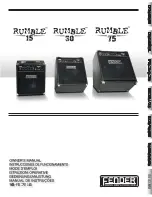
Chapter 2
Basics 55
SR865A DSP Lock-in Amplifier
The signal amplifier bandwidth determines the amount of broadband noise that will be
amplified. This affects the Input Range (analog signal gain). The time constant sets the
amount of post-demodulation noise which will be measured at the reference frequency.
1/f Noise
Every 10 Ω re
sistor, no matter what it is made of, has the same Johnson noise. However,
there is excess noise in addition to Johnson noise which arises from fluctuations in
resistance due to the current flowing through the resistor. For carbon composition
resistors, this is typically 0.1 µV-3 µV of rms noise per Volt of applied across the
resistor. Metal film and wire-wound resistors have about 10 times less noise. This noise
has a 1/f spectrum and makes measurements at low frequencies more difficult.
Other sources of 1/f noise include noise found in vacuum tubes and semiconductors.
Shot Noise
Electric current has noise due to the finite nature of the charge carriers. There is always
some non-uniformity in the electron flow which generates noise in the current. This noise
is called shot noise. This can appear as voltage noise when current is passed through a
resistor, or as noise in a current measurement. The shot noise or current noise is given by
f
I
2
)
rms
(
noise
'
q
I
where
q
is the electron charge (1.6×10
−19
coulomb), I is the RMS ac current or dc current
depending upon the circuit, and ∆f is the bandwidth.
When the current input of a lock-in is used to measure an ac signal current, the bandwidth
is typically so small that shot noise is not important.
Total Noise
All of these noise sources are incoherent. The total random noise is the square root of the
sum of the squares of all the incoherent noise sources.
External Noise Sources
In addition to the intrinsic noise sources discussed previously, there are a variety of
external noise sources within the laboratory.
Most of these noise sources are asynchronous, i.e. they are not related to the reference
and do not occur at the reference frequency or its harmonics. Examples include lighting
fixtures, motors, cooling units, radios, computer screens, etc. These noise sources affect
the measurement by increasing the required dynamic reserve or lengthening the time
constant.
Some noise sources, however, are related to the reference and, if picked up in the signal,
will add or subtract from the actual signal and cause errors in the measurement. Typical
sources of synchronous noise are ground loops between the experiment, detector and
lock-in, and electronic pick up from the reference oscillator or experimental apparatus.
Содержание SR865A
Страница 5: ...Safety and Preparation For Use iii SR865A DSP Lock in Amplifier...
Страница 6: ...iv Safety and Preparation For Use SR865A DSP Lock in Amplifier...
Страница 54: ...36 Getting Started Chapter 1 SR865A DSP Lock in Amplifier...
Страница 118: ......
Страница 172: ......
Страница 186: ...168 The FFT Display Appendix B SR865A DSP Lock in Amplifier...
Страница 192: ......
















































